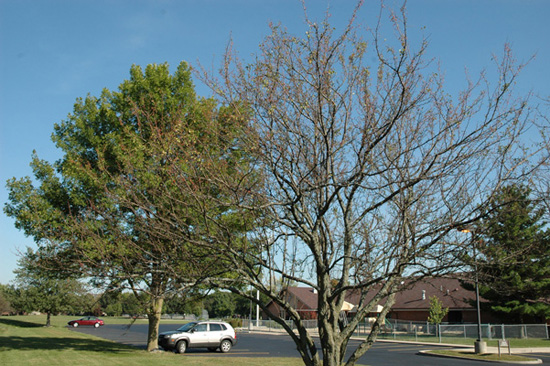Issue 18, October 16, 2009
Crabapple Scab Reduction for 2010
Scab was extremely intense on crabapples and edible apples in the Midwest in 2009. Refer to 2009 issues 5 and 16 of this newsletter for details. The image shows a typical crabapple in 2009, denuded by apple scab. Many have asked how they might reduce the amount of scab in apples and crabapples next year.

The first fact is that the fungus overwinters on fallen leaves and fruit. Those trees that were infected this year have a very good chance of at least an initial infection next year from the pathogen present in fallen plant debris. The second fact is that spores do not move very far. Certainly you will get spread from nearby trees, but not from those a few blocks away. Logically, if you can reduce the amount of fungus under your tree, you will greatly reduce the amount of scab infection next year, even in an ideal scab year.
The most practical means of controlling that first wave of scab next season is to rake and remove fallen leaves. Dr. John Hartman at the University of Kentucky addresses this issue for edible apples in his article which can be viewed here. The pathogen is the same for crabapple scab. It is not practical to rake and remove fallen leaves from apple orchards. Dr. Hartman discusses ways to help hasten the decomposition of these leaves that might be hosting the scab fungus. He discusses chopping and shredding the leaves with a mower to encourage decomposition of small leaf pieces as well as to encourage their consumption by earth worms. He also discusses the use of urea to hasten decomposition. Sinclair and Lyon, in Diseases of Trees and Shrubs, 2nd edition, suggest removing the fallen leaves, composting them, and applying nitrogenous fertilizer to the compost pile. They also state that dolomitic lime applied to the ground around the trees will suppress the maturation of the fungus in the fallen leaves and therefore reduce the amount of spore release in the spring.
These are just a few suggestions to help reduce the battle with crabapple scab in 2010.--Nancy Pataky
Author:
Nancy Pataky